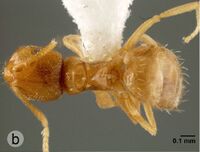Brachymyrmex bahamensis
| Brachymyrmex bahamensis | |
|---|---|

| |
| Scientific classification | |
| Kingdom: | Animalia |
| Phylum: | Arthropoda |
| Class: | Insecta |
| Order: | Hymenoptera |
| Family: | Formicidae |
| Subfamily: | Formicinae |
| Tribe: | Myrmelachistini |
| Genus: | Brachymyrmex |
| Species: | B. bahamensis |
| Binomial name | |
| Brachymyrmex bahamensis Ortiz-Sepulveda, Van Bocxlaer, Meneses & Fernández, 2019 | |
Nothing is known about the biology of Brachymyrmex bahamensis.
Identification
Ortiz-Sepulveda et al. (2019) - Brachymyrmex bahamensis resembles Brachymyrmex termitophilus because both species have scapes that are surpass the posterior margin of the head by a length smaller than the maximal diameter of the eye, their mesonotum does not bulge dorsally above the pronotum, they have erect or suberect hairs on the mesosoma, a gaster with dense pubescence, and yellowish body color. However, the unique feature of Brachymyrmex bahamensis is that it has approximately six erect hairs on the pronotum and two on the mesonotum that are very long, i.e., about twice the length of the maximal diameter of the eye. Brachymyrmex bahamensis also resembles Brachymyrmex heeri, but this latter species has a mesonotum that bulges out dorsally above the pronotum.
Keys including this Species
Distribution
Distribution based on Regional Taxon Lists
Neotropical Region: Bahamas (type locality).
Distribution based on AntMaps
Distribution based on AntWeb specimens
Check data from AntWeb
Countries Occupied
| Number of countries occupied by this species based on AntWiki Regional Taxon Lists. In general, fewer countries occupied indicates a narrower range, while more countries indicates a more widespread species. |

|
Estimated Abundance
| Relative abundance based on number of AntMaps records per species (this species within the purple bar). Fewer records (to the left) indicates a less abundant/encountered species while more records (to the right) indicates more abundant/encountered species. |

|
Biology
Castes
Nomenclature
The following information is derived from Barry Bolton's Online Catalogue of the Ants of the World.
- bahamensis. Brachymyrmex bahamensis Ortiz-Sepúlveda, et al. 2019: 471, fig. 12 (supplemental material S6) (w.q.) BAHAMAS (Andros).
- Type-material: holotype worker, 4 paratype workers.
- Type-locality: holotype Bahamas: Exuma, unnamed cay 175 m. S Staniel Cay, 21.v.1990, 101-90 (L.W. Morrison); paratypes with same data.
- Type-depositories: MCZC (holotype); MCZC, PSWC (paratypes).
- Distribution: Bahamas.
Unless otherwise noted the text for the remainder of this section is reported from the publication that includes the original description.
Description
Worker
Holotype HL1 0.46; HL2 0.31; HL3 0.13; HW 0.41; SL 0.38; EL 0.09; WL 0.45; PnL 0.13; PnW 0.29; ML 0.09; MW 0.19; Indices CI 88.46; SI1 91.30; SI2 120.00; OI1 21.74; OI2 28.85. Paratypes (n = 2). HL1 0.47–0.48; HL2 0.32; HL3 0.14; HW 0.43–0.44; SL 0.39–0.40; EL 0.09–0.10; WL 0.47–0.49; PnL 0.13–0.16; PnW 0.30–0.31; ML 0.09– 0.12; MW 0.21; Indices CI 90.57–90.74; SI 91.67–91.84; SI2 122.22–125.00; OI1 22.45–25; OI2 27.78–28.30.
Head. Slightly longer than wide in full face view; posterior cephalic margin slightly concave. Dorsum of head with appressed hairs and with two rows of erect hairs. Clypeus with a rounded anterior margin and five long, erect hairs of which a single, usually conspicuous hair is near the anterior margin, two hairs are in mediolateral position, and two more near the toruli; other hairs on the clypeus are markedly shorter and appressed or decumbent. Toruli surpassing the posterior clypeal margin in oblique anterodorsal view. The scapes surpass the posterior cephalic margin by a length smaller than the maximal diameter of the eye; they typically have appressed, sometimes decumbent but never erect hairs. Ocelli absent. Eyes are positioned on the cephalic midline and have 8–9 ommatidia along their maximal diameter.
Mesosoma. Approximately six long, erect hairs on the pronotum and two on the mesonotum, each having a length of about twice the maximal diameter of the eye. In lateral view, the mesonotum is not inflated and it does not bulge dorsally above the pronotum. Metanotal groove absent or shallow and narrower than the diameter of the metathoracic spiracles. Dorsum of the propodeum is flat and ~ 1/3th of the length of the propodeal slope. Metathoracic spiracles in dorsolateral position, not protruding, and usually touching the propodeal suture, but not the mesometanotal suture. Propodeal spiracles circular, positioned ventrally of the posterior propodeal margin, posterior of the middle of the propodeal slope. Legs with appressed and scattered hairs. Petiole short and inclined forward.
Gaster. With dense pubescence and several scattered conspicuous long erect hairs.
Color and sculpture. Body usually smooth and shiny, yellowish.
Type Material
Holotype worker (Museum of Comparative Zoology: USNMENT00757689) and Paratype workers (MCZC: USNMENT00757689, Philip S. Ward Collection: USNMENT00757726): five workers. BAHAMAS: Exuma, unnamed cay, 175 m S of Staniel Cay, 21 May 1990, L.W. Morrison 101–90.
The holotype is located at the top of pin USNMENT00757689, with the two paratypes below.
Etymology
In reference of the type locality.
References
References based on Global Ant Biodiversity Informatics
- Ortiz-Sepuvelda C. M., B. Van Bocxlaer, A. D. Meneses, and F. Fernandez. 2019. Molecular and morphological recognition of species boundaries in the neglected ant genus Brachymyrmex (Hymenoptera: Formicidae): toward a taxonomic revision. Organisms Diversity & Evolution https://doi.org/10.1007/s13127-019-00406-2

